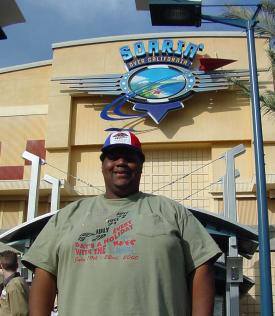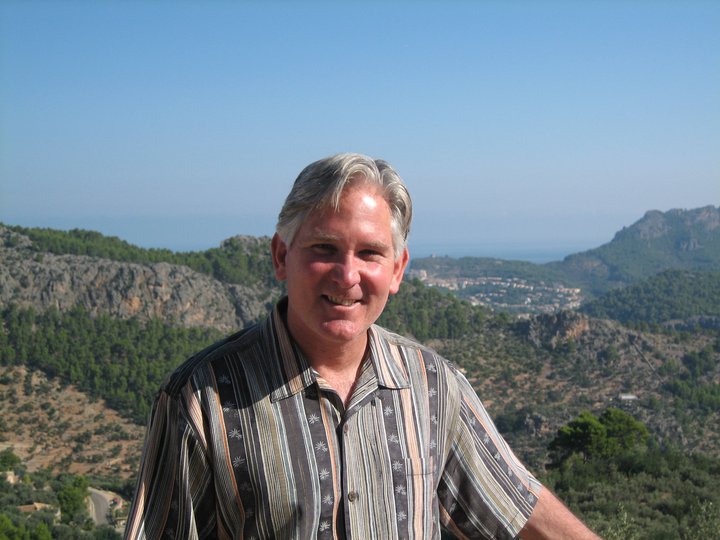Alec Scribner was the show producer for Condor Flats and Soarin’ Over California. His past projects include production designer for the Comedy Warehouse at Pleasure Island and art director at the Magic Kingdom at Walt Disney World including involvement in Mickey’s Toontown Fair and Ariel’s Grotto.
LaughingPlace.com: What were the specific California influences for the design of Condor Flats?
Alec Scribner: When we set out to design the park we wanted to make sure that we captured the geographical diversity of the state. So of course we have Hollywood that represents the city, we have Paradise Pier that represents the sea. We wanted something that represented the high desert. So we thought, why not tell the aviation story which is quite extensive – aviation history here in California. Why don’t we set that in the high desert, akin to Edwards Air Force Base in the Mojave Desert, so that’s kind of why the aviation story is in the high desert. Aviation history – it really started 20 years before the Wright Brothers flew in the 1880s when a guy named John Montgomery flew a glider off the coast of San Diego, and then it really developed from there into the building of the Spirit of St. Louis to the space shuttle and all the way up to the present day. It’s quite extensive.
LP: Did the concept for Soarin’ come first with Condor Flats developed around it?
AS: Yes, it did. That’s a good question, it really did. We wanted to celebrate the diversity of the landscape somehow. We wanted our guests to walk away with an appreciation for how diverse the landscape was here in California, so we thought wouldn’t it be great if we could do that from the air? So that’s when we started thinking about what if we flew over it. and then how are we going to do that. Then we started thinking about how we were going to project it on this big dome screen and all of that. So we knew we wanted to do that. We knew we wanted to tell the aviation story also. So from there, basically the aviation story grew out of Soarin’.
LP: I already talked to Mark Sumner about the ride mechanism for Soarin’. We talked about how unique it was. Given the thought of such a unique attraction and, from what I’ve heard, such an incredible attraction, was there a lot of pressure to make sure the area around it really lived up to the attraction itself?
AS: When we design our parks we always want to do the best job possible that we can. We always have our self-inflicting pressures to make sure that everything is designed as accurately and as best as possible.
LP: Condor Flats is pretty small. Is there any room at all for expansion there?
AS: Not really. We want to respect our distance between ourselves and the park hotel. We felt that the hotel needed some breathing room so we always had a set distance that we really did not want to encroach on because it would crowd the hotel. We felt that wouldn’t be good for our hotel guests. So what we have is what we got.
LP: There is a nice segue way between Condor Flats and the Grizzly area which is a separate area. I don’t really see any other areas in DCA with that smooth transition. Was that by design here?
AS: It was kind of by design because if you think of the Mojave Desert and its relationship to the Sierra Mountains, they’re actually in close proximity as you drive up to Mammoth or to Bishop up that way. You basically go from the Mojave up into the Sierra Mountains which is exactly what we have. So our transition is actually a more natural one from a geographical landscape standpoint.
LP: Was there any one thing that stands out in your mind as one of the bigger challenges of developing the Condor Flats area?
AS: It really has to do with developing that ride. We had three challenges in developing that ride. One was to create a ride system, as Mark told you about, how we were going to get guests safely up into this projection dome and be able to have them there safely. The next one was to basically create a film which we had never done before, that format, a film – and a dome if you will – we had never done a film like that. Then finally the challenge of the projection system. This is a unique projection system. Because the film is actually a forward motion through space, what tends to happen when you film like that is you get strobing if you’re filming regular motion picture speed, and we knew that going into this. Some of us had seen the motion picture projection system by IMAX where they project back instead of 24 frames a second, they project back at 48 which is twice the speed of regular motion picture film. What that in a sense does it gives the eye much more information and makes the imagery so much clearer and all of that strobing goes away. But obviously, if you’re going to make a projector work twice as hard as it is normally used to we’re going to have to do some work to get it there. We did that work.
LP: The vehicles themselves – how much do they move up and down and forwards and backwards during the ride?
AS: They move up and down – what we call heave. It moves up and down about 30 inches and then we actually pitch you back and forth five degrees in each direction. We played with the idea of doing what’s called roll. When a plane goes into a roll it basically banks. And we found that the heave was a better decision to go with because the camera mounted on the helicopter could do all of the roll as we do in our CircleVision films. We’re not moving, but we think we are because we grasp onto that rail. So the decision to go with the heave and the pitch was the right decision.
LP: One of the best I’ve heard from some of our readers is Soarin’ Over California is the next generation CircleVision. I think that’s a great description of it. I like that it’s an attraction for the whole family. It’s not a thrill ride at all. Was that by design from the beginning?
AS: Absolutely. Absolutely. We never wanted to create a Star Tours type of ride. Star Tours is a great ride. It was innovative in its time. I still think it’s a great ride. But we really wanted more of a lyrical, romantic experience for our guests. We wanted to take their breath away. We really wanted the imagery to be the show and as I programmed the ride system I really tried to make it very transparent and invisible to the guests. I wanted it to compliment the imagery that was on the film because if the guests start thinking “wait, no, I see how I’m moving,” now I’ve taken them away from the beauty that is on the screen. I just decided, and I think I was right with my colleagues, that what is on the screen is the right focal point.
LP: One of the things I also hear about is the music. Talk a little bit about that.
AS: I’m a big music fan. Honestly this was one of the high points of the attraction for me. We had the great luck to hire a gentleman by the name of Jerry Goldsmith whose extensive musical career started with Planet of the Apes. He did the Mulan score for us for feature animation. We knew that the music was going to have a big role in this. The imagery was great but the music was really going to push it over the edge. I’ll tell you honestly, and I know you’re not asking me this question, but the best moment in this entire project for me was when we took we took his film score, we cut it to the film, and we put it in the theater and the first moment – I had ridden the ride 200 times by then with just a, we had dropped in a temp track. The first time we went up and we listened to that score it brought tears to my eyes. It was that powerful. It was the proudest moment I’ve ever had on a project. It was that ten seconds. It was unbelievable.
LP: The other really memorable thing is the scents. What is the technology behind doing something like that?
AS: We’ve developed for our other films as well. We have them in books we have them in our other shows. What is unique about this, we weren’t sitting in a theater, we had a ride system now. We had to incorporate the scent to work with the fans and basically deliver those scents. That was one of the hardest things we had to do. My team really had to come up with the scent of a pine, the scent of an orange. Oranges are actually quite easy but coming up with a pine that didn’t smell like Pine-Sol, everyone commented it smells like I just cleaned my kitchen. We had to go back and forth and finally it dawned on me what we needed to do was add an earthy quality to the pine to really make it feel like you were in a forest and it really made it much more organic. Once it dawned on us that’s what we needed to do then the task became a lot easier.
LP: Is there one little detail in Condor Flats, one of your favorites, that people should keep a look out for?
AS: Honestly I love Soarin’ but that little flight shop, Fly ‘n’ Buy, I’ve got a warm spot in my heart for that little place. I think the story around it developed beautifully. I think the fact that we were able to get that little land speed racer in there and prop it as beautifully as we did. I’m extremely proud of the team that I worked with on that. A fellow named Jim Armstrong I think did yeoman’s work pulling all of that together along with our prop person in Marion Mcnara. They did a great job. It’s kind of an unsung hero in the land but we’re really proud of that little shop, we really are.

LP: One of the first things I bought in the park was a Soarin’ Over California propeller hat from that shop.
AS: (laughs) Excellent, excellent.
LP: Is there anything that disappointed you at all about the way Condor Flats turned out?
AS: I wish we’d known it was going to be this popular. I think we would have thought about how we were going to queue people through the area and develop it a little bit differently. Don’t get me wrong, I’m really glad it is this popular but I think if we’d known we would have approached the design of the land a bit different.


